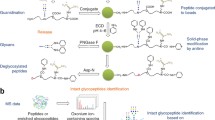Abstract
Most glycoproteins carry a very heterogeneous mixture of oligosaccharides and even a single glycosylation site of a pure glycoprotein is often heterogeneously glycosylated. The structural diversity of oligosaccharides arises from linkage variants, from differences in the size and number of charges of glycans, and from differences in the monosaccharide composition of glycans. Fortunately, the biosynthetic pathway is subject to certain restrictions, so that structural diversity is limited and amenable to laboratory investigation. Different approaches have been developed to the structural characterization of oligosaccharides, including nuclear magnetic resonance (NMR), mass spectrometry, linkage analysis by gas chromatography-mass spectrometry (GC-MS), sequence analysis using specific exoglycosidases, and others, but a crucial part of these strategies is the separation of the glycan mixture into homogeneous glycan fractions. In this chapter some high-performance liquid chromatography (HPLC) techniques are described for the isolation of oligosaccharides, in particular N-linked glycans.
Access this chapter
Tax calculation will be finalised at checkout
Purchases are for personal use only
Similar content being viewed by others
References
Berger M, Kaup M, Blanchard V (2012) Protein glycosylation and Its Impact on biotechnology. Adv Biochem Eng Biotechnol 127:165–185
Blanchard V, Gadkari RA, Gerwig GJ et al (2007) Characterization of the N-linked oligosaccharides from human chorionic gonadotropin expressed in the methylotrophic yeast Pichia pastoris. Glycoconj J 24:33–47
Davies MJ, Hounsell EF (1996) Carbohydrate chromatography: towards yoctomole sensitivity. Biomed Chromatogr 10:285–289
Davies MJ, Hounsell EF (1998) HPLC and HPAEC of oligosaccharides and glycopeptides. Methods Mol Biol 76:79–100
Churm SC (1995) In: El Rassi Z (ed) Carbohydrate analysis: high performance liquid chromatography and capillary electrophoresis. Elsevier, New York, pp 103–146
Huber CG, Bonn GK (1995) In: El Rassi Z (ed) Carbohydrate analysis: high performance liquid chromatography and capillary electrophoresis. Elsevier, New York, pp 147–180
Townsend RR (1995) Carbohydrate analysis: high performance liquid chromatography and capillary electrophoresis. Elsevier, New York
Blanchard V, Gadkari RA, George AV et al (2008) High-level expression of biologically active glycoprotein hormones in Pichia pastoris strains--selection of strain GS115, and not X-33, for the production of biologically active N-glycosylated 15N-labeled phCG. Glycoconj J 25:245–257
Guile GR, Rudd PM, Wing DR et al (1996) A rapid high-resolution high-performance liquid chromatographic method for separating glycan mixtures and analyzing oligosaccharide profiles. Anal Biochem 240:210–226
Hardy MR, Townsend RR (1988) Separation of positional isomers of oligosaccharides and glycopeptides by high-performance anion-exchange chromatography with pulsed amperometric detection. Proc Natl Acad Sci U S A 85:3289–3293
Hardy MR, Townsend RR (1994) High-pH anion-exchange chromatography of glycoprotein-derived carbohydrates. Methods Enzymol 230:208–225
Hoffman RC, Andersen H, Walker K et al (1996) Peptide, disulfide, and glycosylation map** of recombinant human thrombopoietin from ser1 to Arg246. Biochemistry 35:14849–14861
Stroop CJ, Weber W, Gerwig GJ et al (2000) Characterization of the carbohydrate chains of the secreted form of the human epidermal growth factor receptor. Glycobiology 10:901–917
Thayer JR, Rohrer JS, Avdalovic N, Gearing RP (1998) Improvements to in-line desalting of oligosaccharides separated by high-pH anion exchange chromatography with pulsed amperometric detection. Anal Biochem 256:207–216
Kotani N, Takasaki S (1998) Analysis of 2-aminobenzamide-labeled oligosaccharides by high-pH anion-exchange chromatography with fluorometric detection. Anal Biochem 264:66–73
Weitzhandler M, Pohl C, Rohrer J et al (1996) Eliminating amino acid and peptide interference in high-performance anion-exchange pulsed amperometric detection glycoprotein monosaccharide analysis. Anal Biochem 241:128–134
Hase S (1994) High-performance liquid chromatography of pyridylaminated saccharides. Methods Enzymol 230:225–237
Anumula KR (1994) Quantitative determination of monosaccharides in glycoproteins by high-performance liquid chromatography with highly sensitive fluorescence detection. Anal Biochem 220:275–283
Bigge JC, Patel TP, Bruce JA et al (1995) Nonselective and efficient fluorescent labeling of glycans using 2-amino benzamide and anthranilic acid. Anal Biochem 230:229–238
Takahashi N (1996) Three-dimensional map** of N-linked oligosaccharides using anion-exchange, hydrophobic and hydrophilic interaction modes of high-performance liquid chromatography. J Chromatogr A 720:217–225
Anumula KR, Dhume ST (1998) High resolution and high sensitivity methods for oligosaccharide map** and characterization by normal phase high performance liquid chromatography following derivatization with highly fluorescent anthranilic acid. Glycobiology 8:685–694
Blanchard V, Liu X, Eigel S et al (2011) N-glycosylation and biological activity of recombinant human alpha1-antitrypsin expressed in a novel human neuronal cell line. Biotechnol Bioeng 108:2118–2128
Lieke T, Grobe D, Blanchard V et al (2011) Invasion of Trypanosoma cruzi into host cells is impaired by N-propionylmannosamine and other N-acylmannosamines. Glycoconj J 28:31–37
Nuck R, Gohlke M (1997) In: Townsend RR (ed) Techniques in Glycobiology: Characterization of subnanomolar amounts of N-glycans by 2-aminobenzamide labelling, matrix-assisted laser desorption ionization time-of-flight mass spectrometry, and computed-assisted sequence analysis. Marcel Dekker, New York, pp 491–507
Reinke SO, Bayer M, Berger M et al (2012) The analysis of N-glycans of cell membrane proteins from human hematopoietic cell lines reveals distinctions in their pattern. Biol Chem 393:731–747
Wedepohl S, Kaup M, Riese SB et al (2010) N-glycan analysis of recombinant L-Selectin reveals sulfated GalNAc and GalNAc-GalNAc motifs. J Proteome Res 9:3403–3411
Gohlke M, Nuck R, Kannicht C et al (1997) Analysis of site-specific N-glycosylation of recombinant Desmodus rotundus salivary plasminogen activator rDSPA alpha 1 expressed in Chinese hamster ovary cells. Glycobiology 7:67–77
Hermentin P, Witzel R, Doenges R et al (1992) The map** by high-pH anion-exchange chromatography with pulsed amperometric detection and capillary electrophoresis of the carbohydrate moieties of human plasma alpha 1-acid glycoprotein. Anal Biochem 206:419–429
Frisch E, Kaup M, Egerer K et al (2011) Profiling of Endo H-released serum N-glycans using CE-LIF and MALDI-TOF-MS – application to rheumatoid arthritis. Electrophoresis 32:3510–3515
Gohlke M, Mach U, Nuck R et al (2000) Carbohydrate structures of soluble human L-selectin recombinantly expressed in baby-hamster kidney cells. Biotechnol Appl Biochem 32(Pt 1):41–51
Author information
Authors and Affiliations
Corresponding author
Editor information
Editors and Affiliations
Rights and permissions
Copyright information
© 2019 Springer Science+Business Media, LLC, part of Springer Nature
About this protocol
Cite this protocol
Gohlke, M., Blanchard, V. (2019). Chromatographic Profiling of N-Glycans. In: Kannicht, C. (eds) Post-Translational Modification of Proteins. Methods in Molecular Biology, vol 1934. Humana, New York, NY. https://doi.org/10.1007/978-1-4939-9055-9_6
Download citation
DOI: https://doi.org/10.1007/978-1-4939-9055-9_6
Published:
Publisher Name: Humana, New York, NY
Print ISBN: 978-1-4939-9053-5
Online ISBN: 978-1-4939-9055-9
eBook Packages: Springer Protocols




